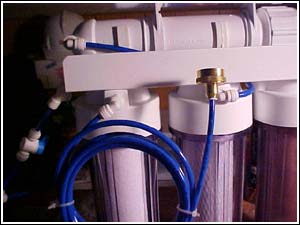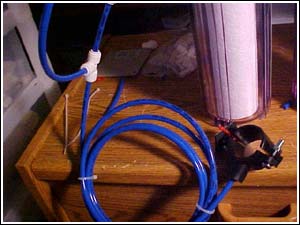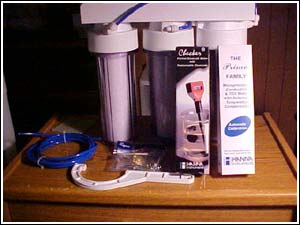

 |
||||||||||||
 |
||||||||||||
| RO Unit Components: Basic Assembly | ||||||
| Page 7 of 7 | Pages: 1 . 2 . 3 . 4 . 5 . 6 . 7 | |||||
 Photo 21: The waste saddle is then assembled and attached to the flush valve with more extra tubing.
Photo 21: The waste saddle is then assembled and attached to the flush valve with more extra tubing.
 Photo 22: I then assemble the extra free goodies and the unit is ready to be boxed for shipping.
Photo 22: I then assemble the extra free goodies and the unit is ready to be boxed for shipping.
 Photo 23: Included with Ralph's unit are extra tubing, a self-piercing valve for connecting to steel or copper water feed pipes, a filter wrench, and his choice of a Primo TDS meter or a Checker pH meter.
Photo 23: Included with Ralph's unit are extra tubing, a self-piercing valve for connecting to steel or copper water feed pipes, a filter wrench, and his choice of a Primo TDS meter or a Checker pH meter.
Detailed instructions for installation, maintenance and operation are also included. The pressure and temperature of the incoming feed water determine the output of the unit and the amount of waste water produced per gallon of filtered water. The Filmtec membranes that I use provide their rated production (75 Gallons per Day in this case) at the following feed water conditions: 77 Degrees F., 50 PSI (as opposed to Osmotic membranes which are rated at 60), pH of 8.00 and 200 PPM TDS. Anything below the rated temperature or pressure results in the unit producing less filtered water. Higer temperatures and pressures increase the output. This is why a booster pump is beneficial to people who have cold or low pressure feed water. Lower pH and TDS increase the output. The freqency of changing prefilters depends again on the TDS of the feed water. The easiest way to determine if your prefilters need to be changed is to check the TDS of the product water with the handy TDS meter you get free with my RO unit. If this is a DI unit you will have to watch the amount of water produced. If the quantity drops, it is time to change the prefilters. I recommend changing prefilters every six months in water that is 200 PPM TDS or lower, every three months in 201 to 400 PPM TDS feed water and monthly in 401 and higher. The fifth stage polishing filter should be changed yearly. And yes, it's in the instructions. I know people that let their waste water run down the drain. I also know people that use the water to do water changes in juvenile discus and African cichlids grow out tanks. The waste water is clean, filtered, dechlorinated water that is slightly higher in TDS than the feed water right from the tap. There is no problem with using this water for water changes if you have the space to store it. A couple of trash cans or 55 gallon drums with an overflow to the drain would be perfect. |
 |
|||||
| About Us :: Message Board :: Chat | |||||
| Library :: Photo Gallery :: Links & Resources :: Breeders & Sponsors :: Merchandise | |||||
| Website designed by: EthanCote.com | © 2001-2004, SimplyDiscus.com. All Rights Reserved. | ||||